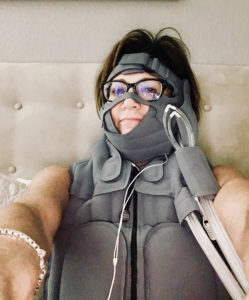HNCA Ambassador and Oral Cancer Survivor, Jacki Rogozinski, Shares Her Experience with Lymphedema (Part 2)

The greatest likelihood of developing lymphedema occurs in the first five years after cancer treatment, although the risk is lifelong. I started seeing symptoms quite soon, within a couple of months after treatment. Because lymphedema is a progressive condition, one that worsens over time if left untreated, early intervention will lead to the best outcomes. So, if you’re experiencing symptoms, it’s important to seek treatment as soon as possible.
The primary symptoms of mild to moderate head and neck lymphedema:
- Visible swelling of the neck, under the chin, or
of the face including lips, cheeks, and eyelids - A feeling of tightness in these areas, including
the jaw and shoulders
It’s worth noting that lymphedema isn’t just an appearance
or “vanity” issue. (I’ve actually had well-meaning friends minimize it,
suggesting that some facial puffiness should be the least of my concerns after
surviving cancer). The fact is, chronic lymphedema can have some serious side
effects.
Beyond the external swelling, head and neck patients may
experience internal lymphedema which involves the mucous membranes of the mouth
and throat. This can lead to vocal changes, difficulty swallowing, a sense of
something stuck in the throat, difficulty breathing and even trouble with
vision. Poorly managed lymphedema can lead to increased inflammation,
infection, and permanent fibrosis, or scarring, of the tissues.
Treatment for Lymphedema
The first step in getting help for my lymphedema was finding
a Certified Lymphedema Therapist (CLT) who specializes in this treatment. These
providers are highly educated on the lymphatic system and trained in management
principles and techniques. I was very fortunate to find a qualified therapist
where I live in Austin, Dr. Angela Wicker-Ramos, founder of Cancer Rehab and
Integrative Medicine, and was able to access treatment within a few months
after noticing symptoms. Again, the sooner the better; early intervention is
best!
Make sure your therapist is certified with the CLT credentials listed after his or her name. Here are a few resources for finding a Certified Lymphedema Therapist:
The gold standard for lymphedema treatment is Complete Decongestive Therapy, or CDT. CDT is a combined approach to manage lymphedema through a variety of interventions:
- Manual Lymphatic Drainage – a special type of massage to help stimulate and redirect the flow of lymph
- Compression – bandages and garments used to reduce swelling
- Education – prevention and management skills, self-massage, skin care and risk reduction
- Decongestive Exercise – deep breathing, stretches, strength training
My initial visit with my therapist included measurements of
my swollen areas and assessments of the range of motion of my mouth, jaw, neck,
head and shoulders. I learned helpful stretches and exercises to strengthen and
improve motion and relieve tightness. Not only did my therapist perform the
specialized massage treatment on me, but she taught me the manual lymphatic
drainage techniques so I could continue them on my own.
Fairly soon after treatment began, I was fitted for a
compression garment to wear overnight; I must admit, it was uncomfortable at
first and can be rather hot for sleeping during Austin summers! I greatly
welcomed the suggestion of wearing it intermittently for an hour or two at a
time throughout the day as an alternative.

A few months later, Dr. Wicker-Ramos referred me as a
candidate for a home lymphedema pump, the FlexiTouch system. Thankfully, my
insurance authorized partial coverage of the advanced pneumatic compression
device for my use at home. I now faithfully strap myself into my treatment gear
every day and settle in for the 35-minute session. This device has been a wonderful
addition to my home treatment and allows me to maintain results between
revisits to my therapist.
Consistency is one of the most vital aspects of lymphedema management. Establishing care with a qualified CLT is the first step; being consistent with home exercises, lymphatic drainage massage, and compression interventions will be key in successfully treating your lymphedema. While it may feel like another challenge in an already challenging journey, it is definitely one you can manage, armed with the proper knowledge, support and commitment.

Jacki Rogozinski
Healthcare Sales & Marketing Professional
Survivor of Stage IV Oral Cancer
Austin, TX

Special thanks to our partner, Tactile Medical, for sponsoring this cancer survivor blog!
